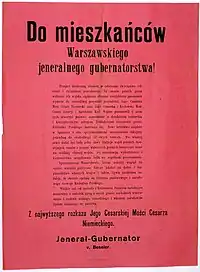Act of 5th November
The Act of 5th November of 1916 was a declaration of Emperors Wilhelm II of Germany and Franz Joseph of Austria. This act promised the creation of the Kingdom of Poland out of territory of Congress Poland, envisioned by its authors as a puppet state controlled by the Central Powers. The origin of that document was the dire need to draft new recruits from German-occupied Poland for the war with Russia. Even though the act itself expressed very little in concrete terms, its declaration is regarded as one of main factors in the Polish efforts to regain independence. Despite official statements, the German Empire really planned to annex up to 30,000 km² of prewar Congress Poland, with expulsion of between 2 and 3 million Poles and Jews out of these territories to make room for German settlers.[1][2][3][4][5][6]

Following the declaration, on 6 December 1916, the Provisional Council of State was created, with Waclaw Niemojowski as its president, and Józef Piłsudski as chairman of its Military Commission. Units of the Polish Military Organisation were put under management of the Provisional Council of State, but the council itself had very limited authority and, after the oath crisis was disbanded in August 1917. It was followed by the Temporary Committee of the Provisional Council of State (Komisja Przejściowa Tymczasowej Rady Stanu) and then by the Regency Council.
The Act of 5th November had a wide impact among the Allies of World War I. In December 1916, the Italian Parliament supported the independence of Poland, and in early 1917, Tsar Nicholas II of Russia returned to the idea of independent Poland, tied in a union with the Russian Empire that Russian officials proposed already in 1914. At the same time, US President Woodrow Wilson also publicly expressed his support of a free Polish state.
Following the Armistice of 11 November 1918 ending the World War I, in spite of the previous initial total dependence of the kingdom on its sponsors, it ultimately served against their intentions as the cornerstone proto state of the nascent Second Polish Republic, the latter composed also of territories never intended by the Central Powers to be ceded to Poland.
See also
References
- Truth or conjecture?: German civilian war losses in the East, page 366 Stanisław SchimitzekZachodnia Agencia Prasowa, 1966
- To the Threshold of Power, 1922/33: Origins and Dynamics of the Fascist and Nationalist Socialist Dictatorships, page 151-152
- Shatterzone of Empires: Coexistence and Violence in the German, Habsburg, Russian, and Ottoman Borderlands by Omer Bartov and Eric D. Weitz page 55 Indiana University Press 2013
- Immanuel Geiss "Tzw. polski pas graniczny 1914-1918". Warszawa 1964
- The Red Prince: The Secret Lives of a Habsburg Archduke By Timothy Snyder "On the annexations and ethnic cleansing, see Geiss, Der Polnische Grenzstreifen"
- Absolute Destruction: Military Culture And The Practices Of War In Imperial Germany Isabel V. Hull page 233 Cornell University Press, 2005
External links
- Proclamation of the German Emperor and the Emperor of Austria, respecting the establishment of a Kingdom of Poland
- Protest of the Russian Government against the Austro-German proclamation of Nov.6, 1916, respecting Poland
- Protest of the Governments of Great Britain, France and Italy, against the Austro-German Proclamation of Nov. 6, 1916, respecting Poland
